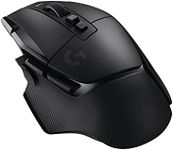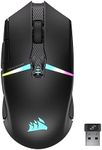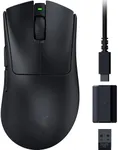Buying Guide for the Best Wireless Gaming Mouses
Choosing a wireless gaming mouse can make a big difference in your gaming experience. The right mouse should feel comfortable in your hand, respond quickly to your movements, and last through long gaming sessions without needing constant recharging. When shopping, it's important to look beyond just the brand or appearance and focus on the features that match your gaming style and needs. Understanding the key specifications will help you find a mouse that enhances your gameplay and feels like a natural extension of your hand.Sensor TypeThe sensor in a gaming mouse detects movement and translates it into cursor movement on your screen. There are two main types: optical and laser. Optical sensors are generally more accurate and consistent for gaming, especially on cloth mousepads, while laser sensors can work on more surfaces but may introduce slight inaccuracies. If you play fast-paced or competitive games, an optical sensor is usually the better choice. For casual gaming or if you use a variety of surfaces, a laser sensor might be more versatile.
DPI (Dots Per Inch)DPI measures how sensitive the mouse is to movement. A higher DPI means the cursor moves further with less physical movement of the mouse. Gaming mice often offer a wide range of DPI settings, from as low as 400 up to 20,000 or more. Low DPI (400-800) is preferred for precise aiming in shooters, while higher DPI (1600-3200+) can be useful for fast movements or large screens. Choose a mouse that allows you to adjust DPI easily, so you can find the setting that feels most natural for your games and play style.
Polling RatePolling rate is how often the mouse reports its position to your computer, measured in Hertz (Hz). Common values are 125Hz, 500Hz, and 1000Hz. A higher polling rate means less delay between your movement and what happens on screen, which is important for fast-paced games. Most gamers will benefit from a 1000Hz polling rate, but if you notice instability or battery drain, you can try a lower setting. For most users, a higher polling rate is better for gaming.
Battery LifeBattery life determines how long you can use the mouse before needing to recharge or replace batteries. Some wireless gaming mice last for days or even weeks on a single charge, while others may need more frequent charging, especially with RGB lighting enabled. If you play long sessions or dislike interruptions, look for a mouse with longer battery life or one that allows you to use it while charging. Consider your gaming habits—if you play often, longer battery life will be more important.
WeightThe weight of a mouse affects how it feels and moves. Lighter mice (under 80 grams) are easier to move quickly and are popular for fast-paced games, while heavier mice (over 100 grams) can feel more stable and controlled, which some users prefer for strategy or slower-paced games. Some mice offer adjustable weights so you can customize the feel. Think about your play style—if you like quick flicks and fast movements, go lighter; if you prefer a steady hand, a heavier mouse might suit you.
Ergonomics and ShapeThe shape and ergonomics of a mouse determine how comfortable it is to hold, especially during long gaming sessions. Some mice are designed for right-handed or left-handed users, while others are ambidextrous. The size and contour should fit your hand size and grip style (palm, claw, or fingertip). Try to choose a mouse that matches your hand and grip for maximum comfort and control. If possible, test different shapes to see what feels best for you.
Buttons and CustomizationGaming mice often have extra buttons that can be programmed for in-game actions or shortcuts. The number and placement of these buttons vary. If you play games that require lots of commands (like MMOs), more buttons can be helpful. For shooters or simpler games, fewer buttons may be better to avoid accidental presses. Look for a mouse with customizable buttons and software that lets you assign functions to suit your needs.
Wireless Technology and LatencyWireless gaming mice use different technologies to connect to your computer, such as Bluetooth or proprietary wireless receivers. The best gaming mice have very low latency, meaning there is almost no delay between your movement and the response on screen. For competitive gaming, look for a mouse that advertises low-latency or 'gaming-grade' wireless performance. If you just play casually, most modern wireless mice will be fast enough.

















